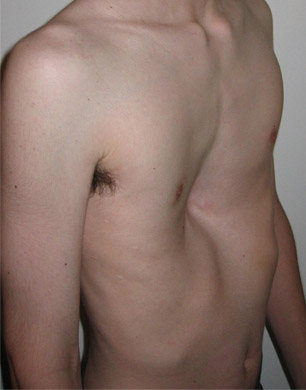WBR0110: Difference between revisions
YazanDaaboul (talk | contribs) No edit summary |
YazanDaaboul (talk | contribs) No edit summary |
||
| Line 22: | Line 22: | ||
|SubCategory=Cardiology, Musculoskeletal/Rheumatology | |SubCategory=Cardiology, Musculoskeletal/Rheumatology | ||
|Prompt=A 16-year-old male adolescent presents to his pediatrician for the evaluation of scoliosis. During physical examination, the physician notes that in addition to his scoliosis, the patient is tall, with an image of his chest shown below. Additionally, he has crowded teeth and dental malocclusion. The patient's metacarpal index is calculated in the clinic and is found to be more than 8. The physician suspects a genetic origin for the patient’s condition. Which of the following may potentially be used to treat this patient’s condition? | |Prompt=A 16-year-old male adolescent presents to his pediatrician for the evaluation of scoliosis. During physical examination, the physician notes that in addition to his scoliosis, the patient is tall, with an image of his chest shown below. Additionally, he has crowded teeth and dental malocclusion. The patient's metacarpal index is calculated in the clinic and is found to be more than 8. The physician suspects a genetic origin for the patient’s condition. Which of the following may potentially be used to treat this patient’s condition? | ||
[[Image:WBR0110.jpg|600px]] | |||
|Explanation=Marfan syndrome is a genetic disorder primarily affecting connective tissue. People with Marfan syndrome tend to be unusually tall, with long limbs and long, thin fingers. Marfan syndrome has a range of [[expressivity]], with clinical symptoms ranging from mild to severe. The most serious complications are typically defects of the heart valves and aorta. Marfan syndrome is a dominant genetic trait, meaning that people who inherit only one copy of the mutated FBN1 gene from either parent will develop Marfan syndrome. | |Explanation=Marfan syndrome is a genetic disorder primarily affecting connective tissue. People with Marfan syndrome tend to be unusually tall, with long limbs and long, thin fingers. Marfan syndrome has a range of [[expressivity]], with clinical symptoms ranging from mild to severe. The most serious complications are typically defects of the heart valves and aorta. Marfan syndrome is a dominant genetic trait, meaning that people who inherit only one copy of the mutated FBN1 gene from either parent will develop Marfan syndrome. | ||
Revision as of 21:09, 8 September 2014
| Author | [[PageAuthor::William J Gibson (Reviewed by Yazan Daaboul, M.D. and Rim Halaby, M.D. [1])]] |
|---|---|
| Exam Type | ExamType::USMLE Step 1 |
| Main Category | MainCategory::Genetics |
| Sub Category | SubCategory::Cardiology, SubCategory::Musculoskeletal/Rheumatology |
| Prompt | [[Prompt::A 16-year-old male adolescent presents to his pediatrician for the evaluation of scoliosis. During physical examination, the physician notes that in addition to his scoliosis, the patient is tall, with an image of his chest shown below. Additionally, he has crowded teeth and dental malocclusion. The patient's metacarpal index is calculated in the clinic and is found to be more than 8. The physician suspects a genetic origin for the patient’s condition. Which of the following may potentially be used to treat this patient’s condition? |
| Answer A | AnswerA::Losartan |
| Answer A Explanation | [[AnswerAExp::Angiotensin receptor blockers have been shown to be useful in patient’s with Marfan syndrome.]] |
| Answer B | AnswerB::Lisinopril |
| Answer B Explanation | AnswerBExp::ACE-inhibitors are used for hypertension and diabetic renal disease. |
| Answer C | AnswerC::Hydrochlorothiazide |
| Answer C Explanation | [[AnswerCExp::Hydrochlorothiazide is a thiazide diuretic which is used to treat hypercalciuria and nephrogenic diabetes insipidus.]] |
| Answer D | AnswerD::Spironolactone |
| Answer D Explanation | [[AnswerDExp::Spironolactone is a potassium sparing diuretic and a competitive aldosterone receptor antagonist. It has antiandrogenic side effects.]] |
| Answer E | AnswerE::Furosemide |
| Answer E Explanation | [[AnswerEExp::Furosemide is a loop diuretic used in the treatment of congestive heart failure and edema.]] |
| Right Answer | RightAnswer::A |
| Explanation | [[Explanation::Marfan syndrome is a genetic disorder primarily affecting connective tissue. People with Marfan syndrome tend to be unusually tall, with long limbs and long, thin fingers. Marfan syndrome has a range of expressivity, with clinical symptoms ranging from mild to severe. The most serious complications are typically defects of the heart valves and aorta. Marfan syndrome is a dominant genetic trait, meaning that people who inherit only one copy of the mutated FBN1 gene from either parent will develop Marfan syndrome.
The syndrome is carried by the gene FBN1, which encodes the connective protein fibrillin-1. Fibrillin-1 protein is essential for the proper formation of the extracellular matrix, including the biogenesis and maintenance of elastin fibers. In addition to being a connective protein that forms the structural support for tissues outside the cell, the normal fibrillin-1 protein binds to an cytokine called transforming growth factor beta (TGF-β). TGF-β signaling has deleterious effects on vascular smooth muscle development and the integrity of the extracellular matrix. Fibrillin-1 directly binds a latent form of TGF-β, keeping it sequestered and unable to exert its biological activity. Researchers now believe, secondary to mutated fibrillin, excessive TGF-β accumulation in the lungs, heart valves, and aorta weakens the tissues and causes the features of Marfan syndrome. Because angiotensin receptor blockers such as losartan block TGF-β activity, they have been used to treat Marfan Syndrome with some efficacy. |
| Approved | Approved::Yes |
| Keyword | WBRKeyword::Marfan, WBRKeyword::Marfan's syndrome, WBRKeyword::Pharmacology, WBRKeyword::Vascular, WBRKeyword::Connective tissue, WBRKeyword::Autosomal dominant, WBRKeyword::Genetics |
| Linked Question | Linked:: |
| Order in Linked Questions | LinkedOrder:: |
